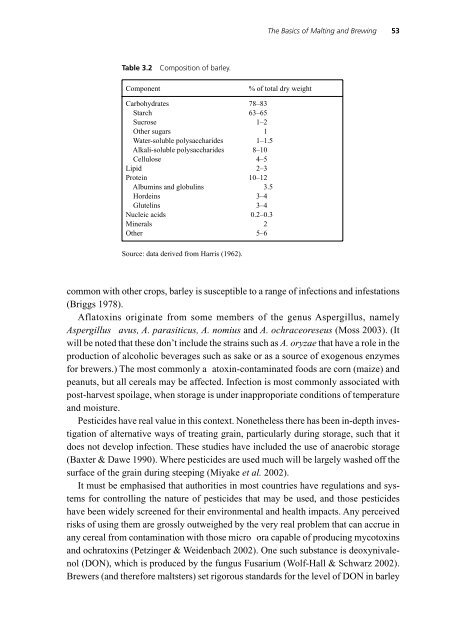Beer : Health and Nutrition
Beer : Health and Nutrition
Beer : Health and Nutrition
Create successful ePaper yourself
Turn your PDF publications into a flip-book with our unique Google optimized e-Paper software.
Table 3.2 Composition of barley.<br />
Component % of total dry weight<br />
Carbohydrates 78–83<br />
Starch 63–65<br />
Sucrose 1–2<br />
Other sugars 1<br />
Water-soluble polysaccharides 1–1.5<br />
Alkali-soluble polysaccharides 8–10<br />
Cellulose 4–5<br />
Lipid 2–3<br />
Protein 10–12<br />
Albumins <strong>and</strong> globulins 3.5<br />
Hordeins 3–4<br />
Glutelins 3–4<br />
Nucleic acids 0.2–0.3<br />
Minerals 2<br />
Other 5–6<br />
Source: data derived from Harris (1962).<br />
The Basics of Malting <strong>and</strong> Brewing 53<br />
common with other crops, barley is susceptible to a range of infections <strong>and</strong> infestations<br />
(Briggs 1978).<br />
Aflatoxins originate from some members of the genus Aspergillus, namely<br />
Aspergillus avus, A. parasiticus, A. nomius <strong>and</strong> A. ochraceoreseus (Moss 2003). (It<br />
will be noted that these don’t include the strains such as A. oryzae that have a role in the<br />
production of alcoholic beverages such as sake or as a source of exogenous enzymes<br />
for brewers.) The most commonly a atoxin-contaminated foods are corn (maize) <strong>and</strong><br />
peanuts, but all cereals may be affected. Infection is most commonly associated with<br />
post-harvest spoilage, when storage is under inapproporiate conditions of temperature<br />
<strong>and</strong> moisture.<br />
Pesticides have real value in this context. Nonetheless there has been in-depth investigation<br />
of alternative ways of treating grain, particularly during storage, such that it<br />
does not develop infection. These studies have included the use of anaerobic storage<br />
(Baxter & Dawe 1990). Where pesticides are used much will be largely washed off the<br />
surface of the grain during steeping (Miyake et al. 2002).<br />
It must be emphasised that authorities in most countries have regulations <strong>and</strong> systems<br />
for controlling the nature of pesticides that may be used, <strong>and</strong> those pesticides<br />
have been widely screened for their environmental <strong>and</strong> health impacts. Any perceived<br />
risks of using them are grossly outweighed by the very real problem that can accrue in<br />
any cereal from contamination with those micro ora capable of producing mycotoxins<br />
<strong>and</strong> ochratoxins (Petzinger & Weidenbach 2002). One such substance is deoxynivalenol<br />
(DON), which is produced by the fungus Fusarium (Wolf-Hall & Schwarz 2002).<br />
Brewers (<strong>and</strong> therefore maltsters) set rigorous st<strong>and</strong>ards for the level of DON in barley

















